I don’t know exactly when “Climb Mount Kilimanjaro” made it onto my bucket list. However, I am aware of the moment I committed to crossing it off the list. I was dating someone so fearful of life he would only eat the same dish for dinner and considered me insane to suggest doing laundry on a day other than Tuesday. Always being the freedom-loving, travel-obsessed type, ending the relationship was liberating. I craved to do something to commemorate the change. I would trek a mountain.
The Risks
By the standards of mountaineering, Kilimanjaro at 19,341 feet is considered ‘very high altitude’, meaning the chances of altitude sickness (vomiting, headaches, fluid accumulation) or death (approximately 1 to 10 annually depending on who you ask) increases with every 1,000 feet. With treks under a week and no technical climbing knowledge needed, it is the most assessable of the Seven Summits climbs. There are only three ways to end a Kilimanjaro trek – successfully summiting, being dragged off the mountain, or volunteering to end your trek.
Preparation
My training for my Kilimanjaro trek proved to be time-consuming and determination-testing. To minimize the chances of altitude sickness, I focused on elevating my cardiovascular fitness. That meant months of swimming, running 10K races, and walking around my home in a not-too-attractive oxygen depriving mask. I also bought Diamox, an altitude sickness medication that causes frequent urination and every over-the-counter medication I could find at my neighborhood pharmacy.
My training proved to be the most stable of the preparatory actions. My family’s reactions were varied, from disbelief to full support. My friends’ expression of panic indicated that my trek will be solo.
In November 2012, I found myself on a flight to Kilimanjaro airport via Amsterdam to undertake my ‘foolhardy’ attempt. How this would end was anyone’s guess.
As a solo trekker, I was given my own guide plus two porters, a cook, and a waiter. I had decided to take the Marangu route. The only route of the six with sleeping huts instead of tents, it is arguably the most luxurious. My belongings (weighing 35 pounds; weight limits are enforced) were either in my daypack or my duffel bag which the porters carried between camps.
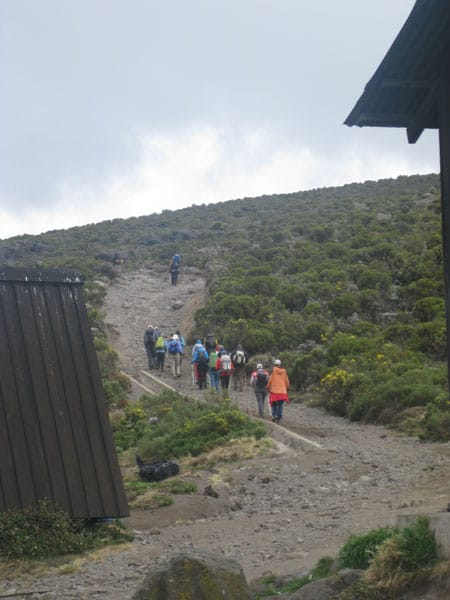
starting out for the day at Hormobo
On the Mountain
The Marangu route has four climate zones – rainforest, moorland, alpine desert, and ice cap at the summit. Typically the trek takes four days, stopping at the Mandara, Horombo, and Kibo camps respectively. I elected for an acclimatization day at Horombo to increase my chances of summiting.
In trekking alone and without a social network, I met people quickly. One such person was a South African woman who I would spend most of my non-trekking time with. She also became my hut roommate (each approximately 300 square feet hut at Mandara and Horombo sleeps four) and Diamox-fueled midnight-search-for-the-outhouse partner. When not sleeping or going to the bathroom we talked about our lives, each of us making disclosures only likely on a mountain in East Africa.
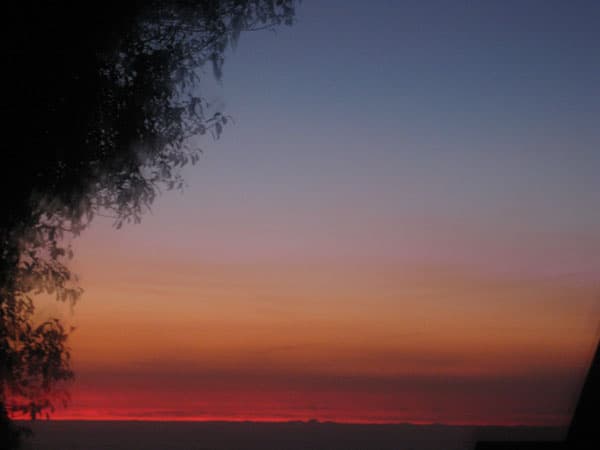
sunrise at Mandara camp on yet another trip to the outhouse
Otherwise, the treks proved to be physically demanding but not enough to immobilize me the next day. I had no problems with altitude except for the usual shortness of breath. The most physically demanding stretch of trekking was between Mandara and Horombo camps. However, that belief may have been influenced by my experiencing a sudden drop in body temperature on that trail. I recovered only after I ingested some water laced with glucose, food and donned an extra jacket I had in my day pack. I believe packing that extra jacket saved my trek.
Summit to Uhuru Peak
The night before my summit attempt, safely in the coed sleeping dorm that is Kibo Hut, I gave myself a highly-charged motivational speech. I was caught between wanting to take a long nap and wanting to trek to the summit and “get it over with”. My new mantra of “Let’s Do It” lulled me to sleep. My rest was short, however. Shortly before 12 midnight, my guide woke me up. It was time to get dressed (4 layers for me plus headlamp) and start the summit.
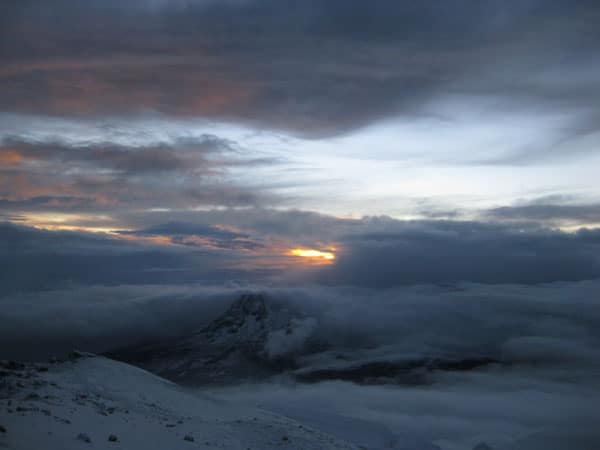
dawn at the peak
There are two summit markers on the Marangu route, Gilman’s Point (5 hours trek from Kibo Hut) and Uhuru Peak (1 and 1/2 hours trek from Gilman’s Point). The first hours proved to be unremarkable except for the fatigue of trekking into thinner air. I watched the backs of my guide’s boots, the only thing visible with my headlamp. Occasionally, I would look up to see the outline of a hill. I just need to get over that hill I would tell myself. Each time I seemed to scale a hill, another appeared. I stopped looking up.
At exactly 5 o’clock I reached Gilman’s point. This is a significant achievement and a turn-back point for some. Not me. We keep on. Now on snow, my guide led me through tunnels, alleyways, and ledges. Fueled by the promise of making it, I made less rest stops. At exactly 6:30 AM I summited Kilimanjaro. I had done it!
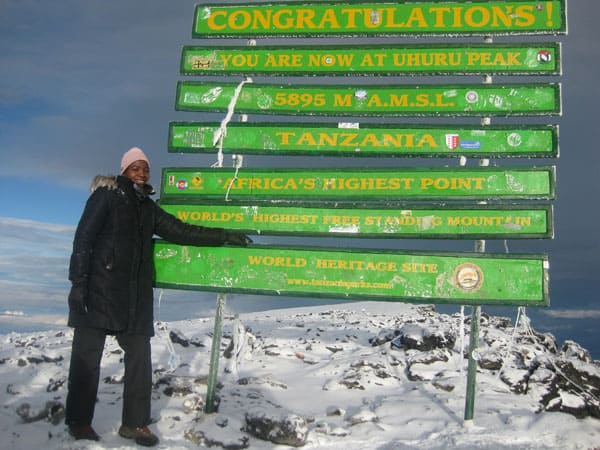
me at the summit, tired but happy
Insights
Action annihilates apathy. Humans have been attempting to summit mountain peaks for centuries. I realized in my trek that the reason for the attempts is the sense of achievement of conquering something that was previously unconquerable. I scared myself and survived. I pushed my self-imposed limits and succeeded. I scared myself and survived. Today, my confidence heightened, I yearn to undertake another limit-breaking feat. Most of all, I relish in not knowing exactly what my next meal will be and doing laundry on a lazy Sunday morning.
Podcast
Learn more about the climbing experience by listening to Climbing Mount Kilimanjaro – Amateur Traveler Episode 699
20 Responses to “Climb Mount Kilimanjaro as a Solo Traveler”
Leave a Reply
Tags: article, kilimanjaro, tanzania

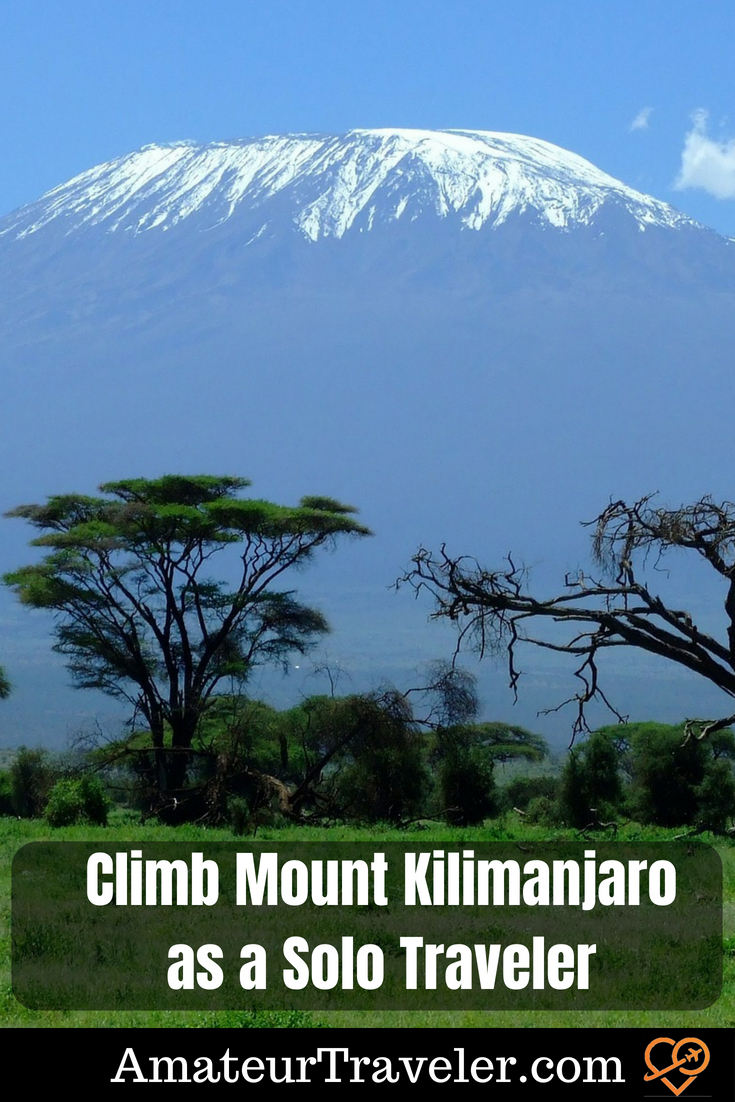
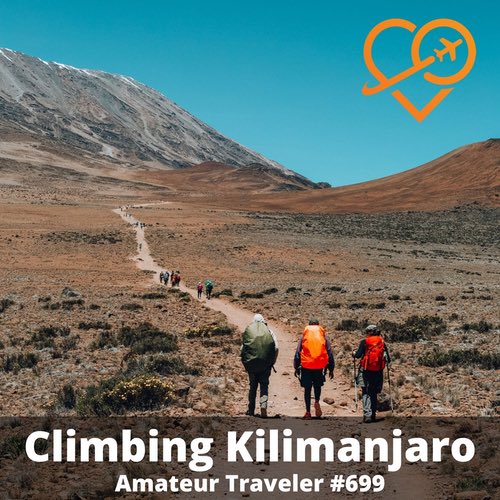 Climbing Mount Kilimanjaro – Episode 699
Climbing Mount Kilimanjaro – Episode 699

Verrill Lagueux
Says:February 4th, 2014 at 12:08 am
Hello!!Climb Mount Kilimanjaro as a solo traveler is adventure you can relax your mind of what you have a problem in your work..Thanks for this blog that you share..
Tom Mc Connell
Says:March 7th, 2014 at 12:25 pm
great description of your trek which company did you trek with
Tom
Elle Marie Campbell
Says:March 9th, 2014 at 7:46 am
Tom,
I went with a local company, Zara Tours. It is much more cost effective to book directly with them.
Kelsey
Says:April 12th, 2014 at 5:52 pm
I am hoping to trek Kilimanjaro solo this summer so thank you for providing some great insight!
chris2x
Says:April 13th, 2014 at 9:54 am
have a great trip!
Nasser
Says:September 18th, 2014 at 4:30 am
Elle! Great job! Thank you for the sharing! I have a question please,,, when you hiked solo, Is the assistant guide is a must? Would he fallow you? How solo is it exactly in Kili?
Kamy
Says:October 12th, 2014 at 6:01 pm
hardly a solo trek with 5 people alongside to serve you!!!!!!
chris2x
Says:October 13th, 2014 at 7:56 am
sounds like my idea of solo travel 😉
Viktoria
Says:April 7th, 2015 at 6:11 am
Thank you so much for this post! I want to do this in 2-3 months.. via Zara Tours.. is there anyone there you recommend dealing with?
Thank you . and kudos for solo female travelers!!! 🙂
JA
Says:May 6th, 2015 at 1:48 pm
HEY! I am looking into doing this exact same thing. Solo. Thanks for your comments…I will definitely check out Zara Tours.
Gabi
Says:January 14th, 2016 at 8:54 pm
I am so glad I found this! Looking to do this solo and very excited to see you did it!
Tamara
Says:January 15th, 2016 at 3:03 am
Great article. How did you find a guide, cook etc? I’m hoping to do a solo trek too 🙂
Tricky
Says:January 28th, 2016 at 7:06 pm
No offense but I began reading this believing you soloed Mount Kilimanjaro. Then i got a few money’s into reading and noticed you wrote you went with a guide. I hope you realize that this isn’t soloing at all? Solo means alone. You were not alone. Well done all the same though
Pawel
Says:March 2nd, 2016 at 2:25 am
“Solo climb”, because a guide and porters are not people. What a joke.
giedre
Says:April 25th, 2017 at 8:10 am
that is not solo tracking! haha
Adrian
Says:May 6th, 2017 at 5:31 am
This is joke. Solo trek with Guide, two porters, cook and waiter. You waisting people time writing such a things.
Matthew Riley
Says:April 24th, 2019 at 9:14 am
Well done for the climb. The article stated “solo traveller’ not solo climber..the negative comments aren’t appropriate. What I find upsetting is the cost being placed by online tour operators. Better to book in person in Tanzania in person. Also, I wish to climb it, like my parents, self-supported as it’s a greater reward for the additional planning. I hate the concept of paying a fee for accessing nature.
Pawan Basnett
Says:September 8th, 2020 at 12:04 am
This is for those people who have commented above but who need to know a little bit more about solo travel. In literal sense, solo travel means to travel alone, but in trekking industry solo travel does not always mean to hike alone. Generally, tour companies take in a small or large group of travelers (anywhere between 3 – 20 or more people) in one go. But, if a person does not want to trek in a group, it can mean solo travel inspite of being accompanied by a guide, porter and cook. Some countries have their own regulations and when they mean traveling solo, it means a ‘single foreign visitor’ will be traveling along with few crew members of the tour agency. Hope this is clear
Jennifer
Says:October 15th, 2021 at 6:17 am
I loved the article!! I just booked my solo trek as well! I wish you would have given us some more details on the training part, for those of us trying to properly train 🙂 thanks for this!
Pratikshya
Says:July 31st, 2022 at 3:01 am
Interesting plus Informative blog which is helpful for solo Travelers.